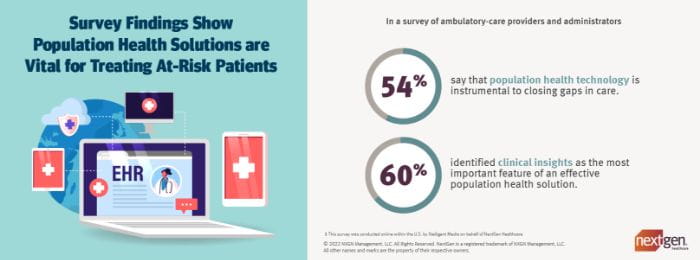A population health strategy is essential as the healthcare industry transitions to value-based care. However, for ambulatory practices, putting a population health strategy into operation remains a challenge.
Research from the Centers for Disease Control and Prevention (CDC) shows a steady growth in population health over time, but recent events—the COVID-19 pandemic and resulting health crises—call for provider organizations to accelerate their use of population health strategies and tools to optimally match risk-based levels of care required by patients with available healthcare resources.
To fully understand the challenges and best practices for population health adoption in ambulatory care, NextGen Healthcare commissioned Xtelligent Healthcare Media to survey leaders of ambulatory medical practices. The survey is the second in a series to monitor health IT adoption in ambulatory facilities. This report emphasized population health solutions to understand the technology’s relationship with overall health IT strategies and the challenges to putting population-health-specific solutions into operation.
Results highlight three key trends:
1. Delivering clinical insights is the most important capability sought in population health solutions.
2. Population health solutions are expected to have the greatest impact on targeted interventions, specifically closing gaps in care.
3. Making data actionable and integrated into clinical workflows are the biggest barriers to using clinical and financial population health data.
Challenges to population health mirror those of health IT adoption in general. For population-health solutions to prove beneficial, they must extend beyond data capture to provide decision-makers with actionable insights. Only fully integrated solutions that give providers actionable data will ultimately help improve patient outcomes.
Trend 1: Deliver clinical insights
When providers consider health IT capabilities for population health, they are primarily concerned with the ability of the solution to offer insights to inform clinical decision-making. Nearly two-thirds of respondents (60%) identified clinical insights as the most important feature of an effective population health solution, followed closely by the ability to perform patient outreach (52%).
Providers want transparency, timeliness and accuracy in population health data and insights. Armed with clinical data like care gaps and risk scores, providers can identify the patients most at risk for adverse outcomes and intercept at the point of care. Those same insights are tremendously valuable when determining the need for between visit care. Paired with the ability to perform patient outreach, the care team can focus on delivering the right level of care to the right patients at the right time.
Trend 2: The greatest impact
Most ambulatory care leaders see the population health solutions integrated into their EHR technology as instrumental to closing gaps in care (54%). Many also anticipate that the technology itself will have a direct impact on targeted interventions, such as closing care gaps, patient outreach, and care management.
Consistent with the first trend noted in this survey, ambulatory care leaders and providers have the expectation that population health technology will not only provide the data, but also the actionable insights that drive interventions specific to the individual patient or even patient cohorts. Given the resource challenges that most providers face, the more technology can do to facilitate efficient interventions by the clinical team, the broader the impact.
Trend 3: Make data actionable and integrated
One of the biggest challenges to successful uptake of population health technology is provider adoption. Providers do not want to use a solution that is not integrated with the technology they already use the most—the EHR (56%).
Clinicians simply don’t have time to access additional systems to hunt for possible relevant clinical and financial data and insights while seeing patients in clinic. As a result, insights from population health solutions need to be patient-specific and focused, which allows the care team to act on the interventions within their scope of practice. Effective population health solutions must provide the right information in the right way at the right time at the point of care, otherwise they will fail to engage the clinicians who need them most.
How to deliver data
Health IT solutions are increasingly popular among provider organizations looking for success in value-based care. But successful population-health strategies are not solely contingent on high-quality data. While an important piece of the population health puzzle, data alone does not make a strategy successful. Data must be delivered as actionable insights, integrated into provider workflows, and efficient to truly impact patient care.
For more detail, visit our Population Health trends report here.
Subscribe to the NextGen® Advisors blog to keep updated with the latest news and issues impacting the healthcare community.






